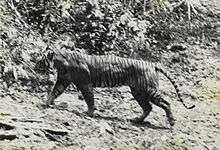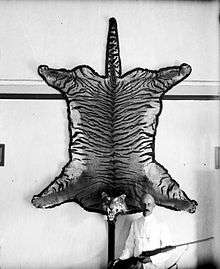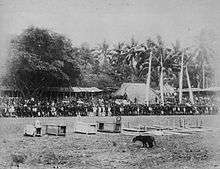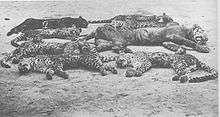Javan tiger
| Javan tiger Temporal range: Late Pleistocene - Holocene | |
|---|---|
 | |
| Javan tiger photographed by Andries Hoogerwerf in Ujung Kulon National Park, 1938[1] | |
| Scientific classification | |
| Kingdom: | Animalia |
| Phylum: | Chordata |
| Class: | Mammalia |
| Order: | Carnivora |
| Suborder: | Feliformia |
| Family: | Felidae |
| Subfamily: | Pantherinae |
| Genus: | Panthera |
| Species: | P. tigris |
| Subspecies: | P. t. sondaica |
| Trinomial name | |
| Panthera tigris sondaica (Temminck, 1844) | |
 | |
| Former range of the Javan tiger | |
The Javan tiger was a Panthera tigris sondaica population that lived in the Indonesian island of Java until the mid 1970s.[2][3] It was hunted to extinction and its natural habitat converted for human use.[1] It was one of the three tiger populations in the Sunda Islands.[4]
Formerly, it was regarded as a distinct tiger subspecies, which had been assessed as extinct on the IUCN Red List in 2008.[2] In 2017, felid taxonomy was revised and the Javan tiger subordinated to P. t. sondaica, which also includes the still surviving Sumatran tiger.[3]
Results of mtDNA analysis of 23 tiger samples from museum collections indicate that tigers colonized the Sunda Islands throughout the last glacial period 110,000–12,000 years ago.[5]
Taxonomy
In 1844, Temminck gave the scientific name Felis tigris sondaicus to the Javan tiger.[6]
In 1929, the British taxonomist Reginald Innes Pocock subordinated the tiger under the genus Panthera using the scientific name Panthera tigris.[7][8][9]
In 2017, the Cat Classification Task Force of the Cat Specialist Group revised felid taxonomy and now recognizes the living and extinct tiger populations in Indonesia as P. t. sondaica.[3]
Characteristics


The Javan tiger was small compared to other subspecies of the Asian mainland, but larger than the Bali tiger, and similar in size to the Sumatran tiger.[9] It usually had long and thin stripes, which were slightly more numerous than those of the Sumatran tiger. Its nose was long and narrow, occipital plane remarkably narrow and carnassials relatively long. Based on these cranial differences, the Javan tiger was proposed to be assigned to a distinct species, with the taxonomic name Panthera sondaica.[4]
Males had a mean body length of 248 cm (98 in) and weighed between 100 and 141 kg (220 and 311 lb). Females were smaller than males and weighed between 75 and 115 kg (165 and 254 lb).[9]
The smaller body size of the Javan tiger is attributed to Bergmann’s rule and the size of the available prey species in Java, which are smaller than the cervid and bovid species on the Asian mainland. However, the diameter of its tracks are larger than those of Bengal tiger in Bangladesh, India, and Nepal.[10]
Charles Frederick Partington wrote that Javan and Sumatran tigers were strong enough to break legs of horses or buffaloes with their paws, even though they were not as heavy as Bengal tigers.[11]
Habitat and ecology
At the end of the 19th century, the Javan tiger inhabited most of Java. Around 1850, people living in rural areas still considered it a plague. By 1940, tigers had retreated to remote mountainous and forested areas. Around 1970, the only known tigers lived in the region of Mount Betiri, with an altitude of 1,192 m (3,911 ft), the highest mountain in Java's southeast, which had not been settled because of the rugged and sloping terrain. In 1972, the 500 km2 (190 sq mi) area was gazetted as wildlife reserve. The last tigers were sighted there in 1976.[1][12]
Javan tigers preyed on rusa deer, banteng, and wild boar, less often on water fowl and reptiles. Nothing is known about their gestation period or life span in the wild or captivity. Up to World War II, Javan tigers were kept in some Indonesian zoos, but these were closed during the war. After the war, they were so rare that it was easier to instead obtain Sumatran tigers.[10]
Extirpation



At the beginning of the 20th century, 28 million people lived on the island of Java. The annual production of rice was insufficient to adequately supply the growing human population, so that within 15 years, 150% more land was cleared for rice fields. In 1938, natural forest covered 23% of the island. By 1975, only 8% forest stand remained, and the human population had increased to 85 million people.[10] In this human-dominated landscape, the extirpation of the Javan tiger was intensified by the conjunction of several circumstances and events:[1]
- Tigers and their prey were poisoned in many places during the period when their habitat was rapidly being reduced.
- Natural forests were increasingly fragmented after World War II for plantations of teak, coffee, and rubber, which were unsuitable habitat for wildlife.
- Rusa deer, the tiger's most important prey species, was lost to disease in several reserves and forests during the 1960s.
- During the period of civil unrest after 1965, armed groups retreated to reserves, where they killed the remaining tigers.
Last efforts
Until the mid-1960s, tigers survived in three protected areas that had been established during the 1920s–1930s: Leuweng Sancang Nature Reserve and Ujung Kulon and Baluran National Parks. Following the period of civil unrest, however, no tigers were sighted there. In 1971, an older female was shot in a plantation near Mount Betiri in Java's southeast. Since then, not a single cub has been recorded. The area was upgraded to a wildlife reserve in 1972, at which time a small guard force was established and four habitat management projects were initiated. The reserve was severely disrupted by two large plantations in the major river valleys, occupying the most suitable habitat for the tiger and its prey. In 1976, tracks were found in the eastern part of the reserve, suggesting the presence of three to five tigers. Only a few banteng survived close to the plantations, but tracks of rusa deer, the preferred prey of the Javan tiger, were not sighted.[13]
After 1979, there were no more confirmed sightings of tigers in Meru Betiri National Park. In 1980, Seidensticker and Suyono recommended extending the wildlife reserve and completely eliminating the disruptive influence of humans on the fragile ecosystem. The Indonesian Nature Conservation Authority implemented these recommendations in 1982 by gazetting the reserve as a national park. These measures were, however, too late to save the few remaining tigers in the region.[1] In 1987, a group of 30 students of Bogor Agricultural University (Institut Pertanian Bogor) conducted an expedition to Meru Betiri. In groups of five, they searched the area and found tiger scat and tracks.[14]
In the west of Java lies the Halimun Reserve, today integrated into the Mount Halimun Salak National Park. In 1984, a tiger was killed there; and in 1989, pugmarks were found that were the size of a tiger's. However, an expedition of six biologists conducted in 1990 did not yield any definite, direct evidence for the existence of tigers.[14] A subsequent survey was planned in the Meru Betiri National Park in autumn 1992 with the support of WWF Indonesia, deploying camera traps for the first time. From March 1993 to March 1994, cameras were positioned at nineteen sites, but the cameras did not yield a single picture of a tiger. During this period, no tracks indicating the presence of tigers were discovered.[15] After the final report of this survey had been published, the Javan tiger was declared extinct.[16]
Rumours and indications of the possible presence of tigers in the Meru Betiri National Park prompted the park's Chief Warden Indra Arinal to initiate another search. With support of the Sumatran Tiger Project, twelve members of the park staff were trained in autumn 1999 to set up camera traps and map their observations. The Canadian The Tiger Foundation provided infrared cameras.[17] Despite a year of work, they photographed no tigers, few prey, and many poachers.[18]
Cultural significance
In 1890, Dutch author Jan Gerhard ten Bokkel noted how the fear of tigers brought the people to use superstitious language: "A Javan will never speak about a tiger without calling him 'Mister', it's always: Mr. Tiger. The beast might hear him once, and take revenge at him for merely saying tiger in a familiar way!"[19]
Alleged sightings
Occasional, unofficial reports of Javan tigers surface from enthusiasts who believe the tiger still exists in Java.[20]
In November 2008, an unidentified body of a female mountain hiker was found in Mount Merbabu National Park, Central Java, who allegedly died from tiger attack. Villagers who discovered the body have also claimed some tiger sightings in the vicinity.[21]
Another alleged sighting occurred in Magetan Regency, East Java, in January 2009. Some villagers claimed to have seen a tigress with two cubs wandering near a village adjacent to Lawu Mountain. This news triggered mass panic. Local authorities found several fresh tracks in the location. However, by that time, those animals had already vanished.[22]
Following the October 2010 eruption of Mount Merapi, two Indonesian villagers claimed sightings of a big cat paw print in the residual ash, which sparked rumours that a tiger or leopard was roaming abandoned farms in search of food. Personnel of the nearby national park did not think it was likely that the paw print belonged to a tiger.[23]
In 2016, a Javan tiger was apparently photographed in Mount Arjuno in East Java. The photo went viral, but some were skeptical about the sighting since the forests were not in a good state. An investigation would take place and, if proven true, vigilance would be stricter as the place is favored by hunters.[24]
On 25 August 2017, a wildlife ranger working in Ujung Kulon National Park took a photograph of an alleged Javan tiger while it was feeding on a dead bull. A research team later set out on a ten-day expedition to validate the existence of the tiger. The representative of the research team later said that it will take up to two months to get a strong conclusion.[25][26] A tiger expert identified the animal as a Javan leopard.[27]
See also
References
- 1 2 3 4 5 Seidensticker, J. (1987). "Bearing witness: observations on the extinction of Panthera tigris balica and Panthera tigris sondaica". In Tilson, R. L.; Seal, U. S. Tigers of the world: the biology, biopolitics, management, and conservation of an endangered species. New Jersey: Noyes Publications. pp. 1–8.
- 1 2 Jackson, P.; Nowell, K. (2008). "Panthera tigris ssp. sondaica". IUCN Red List of Threatened Species. Version 2012.2. International Union for Conservation of Nature.
- 1 2 3 Kitchener, A. C., Breitenmoser-Würsten, C., Eizirik, E., Gentry, A., Werdelin, L., Wilting A., Yamaguchi, N., Abramov, A. V., Christiansen, P., Driscoll, C., Duckworth, J. W., Johnson, W., Luo, S.-J., Meijaard, E., O’Donoghue, P., Sanderson, J., Seymour, K., Bruford, M., Groves, C., Hoffmann, M., Nowell, K., Timmons, Z. & Tobe, S. (2017). "A revised taxonomy of the Felidae: The final report of the Cat Classification Task Force of the IUCN Cat Specialist Group" (PDF). Cat News. Special Issue 11.
- 1 2 Mazák, J. H.; Groves, C. P. (2006). "A taxonomic revision of the tigers (Panthera tigris)" (PDF). Mammalian Biology 71 (5): 268–287. Archived from the original (PDF) on 2007-09-06.
- ↑ Xue, H.R.; Yamaguchi, N.; Driscoll, C.A.; Han, Y.; Bar-Gal, G.K.; Zhuang, Y.; Mazak, J.H.; Macdonald, D.W.; O’Brien, S.J.; Luo, S.J. (2015). "Genetic ancestry of the extinct Javan and Bali tigers". Journal of Heredity. 106 (3): 247–257.
- ↑ Temminck, C. J. (1844). "Aperçu général et spécifique sur les mammifères qui habitent le Japon et les iles qui en dépendent". In von Siebold, F.; Temminck, C. J.; Schlegel, H; de Haan, W.; Kiichi Nakazawa; Shigeho Tanaka; Nagamichi Kuroda; Yaichirō Okada. Fauna Japonica sive Descriptio animalium, quae in itinere per Japoniam, jussu et auspiciis superiorum, qui summum in India Batava imperium tenent, suscepto, annis 1825 - 1830 collegit, notis, observationibus et adumbrationibus illustravit Ph. Fr. de Siebold. Mammalia. Lugduni Batavorum: Arnz et Socius. pp. 1–59.
- ↑ Pocock, R. I. (1929). "Tigers". Journal of the Bombay Natural History Society. 33: 505–541.
- ↑ Pocock, R. I. (1939). "Panthera tigris". The Fauna of British India, Including Ceylon and Burma. Mammalia: Volume 1. London: T. Taylor and Francis, Ltd. pp. 197–210.
- 1 2 3 Mazák, V. (1981). "Panthera tigris" (PDF). Mammalian Species. 152: 1–8. doi:10.2307/3504004. JSTOR 3504004.
- 1 2 3 4 Seidensticker, J. (1986). "Large Carnivores and the Consequences of Habitat Insularization: ecology and conservation of Tigers in Indonesia and Bangladesh.". In Miller, S.D.; Everett, D.D. Cats of the world: biology, conservation and management. Washington DC: National Wildlife Federation. pp. 1−42.
- ↑ Charles Frederick Partington (1835). "Felis, the cat tribe". The British cyclopæedia of natural history. Orr & Smith.
- ↑ Treep, L. (1973). On the Tiger in Indonesia (with special reference to its status and conservation). Report no. 164, Department of Nature Conservation and Nature Management, Wageningen, The Netherlands.
- ↑ Seidensticker, J.; Suyono, I. (1980). The Javan Tiger and the Meri-Betiri Reserve, a plan for management. Gland: International Union for the Conservation of Nature and Natural Resources.
- 1 2 Istiadi, Y., Panekenan, N., Priatna, D., Novendri, Y., Mathys, A., Mathys, Y. (1991). Untersuchung über die Carnivoren des Gunung Halimun Naturschutzgebietes. Zoologische Gesellschaft für Arten- und Populationsschutz e.V. Mitteilungen 7 (2): 3–5.
- ↑ Rafiastanto, A. (1994). Camera trapping survey of Javan tiger and other wild animals in Meru Betiri National Park. WWF-IP Project ID 0084-02
- ↑ Jackson, P., Kemf, E. (1994). Wanted alive! Tigers in the wild: 1994 WWF species status report. WWF, Gland.
- ↑ Tilson, R. (1999). Sumatran Tiger Project Report No. 17 & 18: July − December 1999 Archived 2011-07-16 at the Wayback Machine. Grant number 1998-0093-059. Indonesian Sumatran Tiger Steering Committee, Jakarta.
- ↑ Breining, G. (2002). What's Our Zoo Got to Do With It? Minnesota Conservation Volunteer.
- ↑ Bokkel, ten, J. G. (1890). Dominee, pastoor of rabbi? Populaire kritiek (in Dutch). Amsterdam: De Dageraad. p. 13. Retrieved 20 June 2016.
- ↑ Bambang M. (2002). In search of 'extinct' Javan tiger. Archived 2011-06-07 at the Wayback Machine. The Jakarta Post, October 30, 2002.
- ↑ DetikNews Nov 17, 2008: Pendaki Wanita Tewas di Gunung Merbabu, Diduga Diterkam Harimau
- ↑ JawaPos 24 Januari 2009: Harimau Teror Warga Ringin Agung Archived 2009-02-18 at the Wayback Machine.
- ↑ The Sydney Morning Herald (2010) Tiger rumours swirl below Indon volcano The Sydney Morning Herald, 2 November 2010.
- ↑ "Sight of Javan Tiger in Mount Arjuno Went Viral".
- ↑ Dibilang Punah, Harimau Jawa Terpotret di Ujung Kulon DetikNews, 13 September 2017.
- ↑ Aneh, Harimau Jawa yang Disebut Punah Kedapatan Terkam Banteng Liputan 6, 12 September 2017.
- ↑ "Tiger Species Thought Extinct Is Possibly Spotted in Indonesia". Retrieved September 15, 2017.
External links
| Wikispecies has information related to Panthera tigris sondaica |
- Species portrait Panthera tigris and short portrait P. t. sondaica; IUCN/SSC Cat Specialist Group
- The Tiger Foundation (Canada): Javan Tigers in Meru Betiri National Park
- West Javan tiger statue

.jpg)